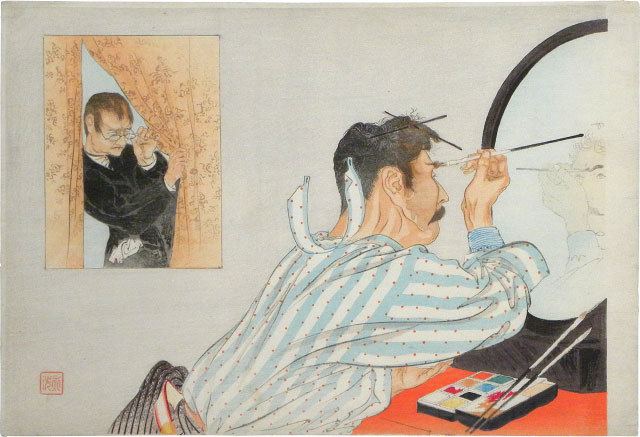

Tomioka Eisen
1866-1908
Abandoned Small Boat
(Sute obune)
kuchi-e (frontispiece) with artist's seal Shisen, ca. 1906
aiban yoko-e 9 1/8 by 12 1/2 in., 23.2 by 31.6 cm
A mustached man is seated at a dressing table wearing a Western-style stripped shirt with his cuffs turned up and his starched collar bowing at the back of his neck, while on his lower half he wears a kimono that is rolled down to his waist. He uses two crisscrossed hair sticks to secure the forelock his unkempt pompadour from flopping into his face while he leans close in towards the mirror as he carefully as darkens his eyebrows. In a rectangular inset cartouche, a sinister-looking man in a black suit lifts a curtain to peer in, adjusting the spectacles perched on his nose.
This kuchi-e (lit. 'mouth picture' or, frontispiece) was published in conjunction with the serialized novel Sute obune (Abandoned Small Boat) by Kuroiwa Ruiko (1862-1920) who had adapted it from the mystery novel, Diavola, or, the Woman's Battle by Mary Elizabeth Braddon (1835-1950) which was first serialized in the London Journal from October 1866 to July 1867. Shortly thereafter it was licensed to the New York Sunday Mercury where it was retitled Nobody's Daughter; or the Ballad-Singer of Wapping. In 1868 it was released as a three-volume novel titled Run to Earth by Ward, Lock and Tyler.
When Ruiko adapted it over twenty-five years later it was serialized into 156 episodes published by the Yorozu choho newspaper from October 1894 until July 1895. In the Ruiko's version, the names of the characters were changed to Japanese names that helped suggest their social status in relation to each other, but the setting remained European. As a result of the popularity of the story, it was adapted again, this time as a kabuki play titled Sute obune yorozu no ojime by Kawatake Shinshichi III (1842-1901) and staged at the Kabukiza in Tokyo in January 1898. In 1906 it was further revised as a modern shingeki (lit. 'new drama') production staged at the Hongoza in Tokyo which would have presented the story utilizing Western-style realism featuring actors in foreign clothing.
References:
Nanako Yamada, Mokuhan Kuchi-e Survey of Woodblock Kuchi-e Prints, 2006, p. 317
Ian Mc Arthur, Mio Bryce, Names and Perspectives in Sute-Obune: A Meiji-Era Adaptive Translation of the Mary Braddon Mystery Novel, Diavola, in The International Journal of the Humanities, 2007
Metropolitan Museum of Art (www.metmuseum.org), accession no. JP3196
(inv. no. 10-4891)
price: Sold






